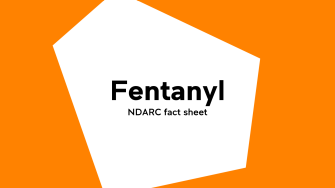15 May 2025
NDARC fact sheet:
Fentanyl
Fentanyl

Fentanyl is a pharmaceutical opioid that is prescribed for the management of severe pain. It is about 80 to 100 times stronger than morphine.
Opioids are depressant drugs that act on the central nervous system and work to slow down messages travelling between the brain and body.
In Australia, fentanyl is available as a restricted medicine (Schedule 8), meaning that it can only be legally obtained with a doctor’s prescription.
Fentanyl, like other opioids, crosses the blood-brain barrier and interacts with opioid receptors in the brain to create a range of responses within the body in addition to pain relief (analgesia).
These may include:
If used as prescribed and recommended, fentanyl is an effective medication. However, there are risks associated with both use and misuse.
Regular use of fentanyl may cause:
As fentanyl is such a potent opioid, there is a serious risk that non-medical use may result in overdose.
The signs of overdose include:
If caught in time, the effects of overdose can be reversed by the administration of naloxone. When medications are used outside the guidelines for safe and effective use, adverse effects may be more likely.
In 2022, 240 overdose deaths were recorded related to the use of synthetic opioids such as fentanyl, tramadol and pethidine.
The effects of taking fentanyl with other drugs, including over the counter or prescription medications, can be unpredictable and dangerous.
For instance, it can increase the risk of adverse effects and respiratory depression if taken with alcohol. Fentanyl mixed with benzodiazepines may increase the sedative effects of both drugs and also increase the risk of respiratory depression, while mixing it with antidepressants may result in severe, unpredictable reactions.
Fentanyl is a powerful opioid, and opioids have the highest dependence liability of all illicit drug classes. This may be a problem if the drug is used over a long period of time.
Usually, withdrawal begins between eight and 12 hours after the last dose.
Withdrawal symptoms may include:
These symptoms generally reach their peak on the third day following cessation.
Other harmful use practices that may lead to dependence include:
Rates of psychopathology amongst people who use opioids for non-medical use are extremely high. Affective disorders are prominent with lifetime rates of severe depression, dysthymia and anxiety disorders.
Treatment for fentanyl dependence differs depending on severity of the addiction, and a range of other factors.
Some treatments include taking opioid agonist or antagonist drugs like buprenorphine, naltrexone or methadone. This pharmacotherapy helps stabilise people with an opioid dependence and reduce harms related to drug use.
Other treatments include behavioural therapy in an inpatient or outpatient setting, cognitive behavioural therapy, specialised treatment programs, and recovery groups.
According to the Australian Institute of Health and Welfare’s National Drug Strategy Household survey, 2.6 million (or 11.9%) people in Australia reported non-medical use of a pharmaceutical drug at some point in their lifetime.
In 2022-23, 5.9% of people aged 14 and over who used painkillers/pain relievers and opioids for non-medical purposes in the previous 12 months, reported using fentanyl.
The Illicit Drug Reporting System (IDRS) is an Australian monitoring system run by the National Drug and Alcohol Research Centre (NDARC) at UNSW Sydney that identifies emerging trends of local and national concern in illicit drug markets.
The Ecstasy and Related Drugs Reporting System (EDRS) is an Australian monitoring system run by NDARC that identifies emerging trends of local and national interest in ecstasy and related drug use, markets and harms.
The Pocket Guide to Drugs and Health is a publication authored by experts from NDARC that provides information for health professionals on the impact of drug use.
The Australian Institute of Health and Welfare collects information on alcohol and tobacco consumption, and illicit drug use among the general population in Australia.
The Australian Bureau of Statistics is Australia’s national statistical agency, providing official statistics on a range of economic, social, population and environmental matters of importance to Australia.
Alcohol and Drug Foundation (2024). Fentanyl. Retrieved from: adf.org.au/drug-facts/fentanyl/
Australian Institute of Health and Welfare (2024). National Drug Strategy Household Survey 2022–2023. AIHW, Australian Government. Retrieved from: aihw.gov.au/reports/illicit-use-of-drugs/national-drug-strategy-household-survey/data
Darke S., Lappin, J., & Farrell M. (2024). The Clinician’s Guide to Illicit Drugs and Health (Revised Edition). London: Silverback Publishing.
Chrzanowska, A., Man, N., Sutherland, R., et al (2024). Trends in overdose and other drug-induced deaths in Australia, 2003-2022. Sydney: National Drug and Alcohol Research Centre, UNSW Sydney. Retrieved from: unsw.edu.au/research/ndarc/resources/trends-drug-induced-deaths-australia-2003-2022
If you, or someone around you, is experiencing undesired or distressing psychological or physical symptoms from the intake of alcohol or other drugs, please seek immediate medical attention.
If you need urgent help from ambulance services, call Triple Zero (000). If a person has been mixing drugs with alcohol or other drugs, tell the paramedic exactly what has been taken.
For free and confidential advice about alcohol and other drugs, call the National Alcohol and Other Drug Hotline on 1800 250 015. The hotline will automatically direct you to the Alcohol and Drug Information Service in your state or territory.
15 May 2025
Fact Sheets
NDARC
Download this resource